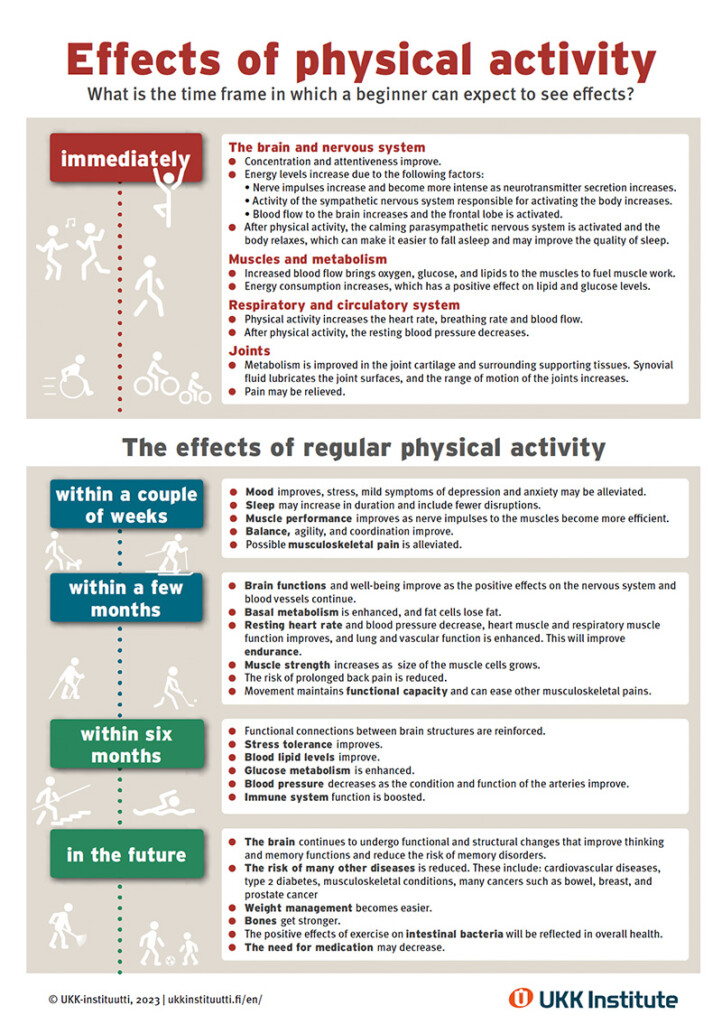Physical activity can immediately make you feel better
- Your mood will improve.
- Your thoughts will be sharper.
- Your feeling of stress will be reduced.
- You will sleep better.
Being sufficiently physically active can add healthy years in your life
Physical activity prevents, treats and rehabilitates many diseases, such as
- cardiovascular diseases
- type 2 diabetes
- musculoskeletal disorders
- some cancers.

Download the infographic about the effects of physical activity for free
Immediate effects of physical activity
The brain and nervous system
- Concentration and attentiveness improve.
- Energy levels increase due to the following factors:
- Nerve impulses increase and become more intense as neurotransmitter secretion increases.
- Activity of the sympathetic nervous system responsible for activating the body increases.
- Blood flow to the brain increases and the frontal lobe is activated.
- After physical activity, the calming parasympathetic nervous system is activated and the
body relaxes, which can make it easier to fall asleep and may improve the quality of sleep.
Muscles and metabolism
- Increased blood flow brings oxygen, glucose, and lipids to the muscles to fuel muscle work.
- Energy consumption increases, which has a positive effect on lipid and glucose levels.
Respiratory and circulatory system
- Physical activity increases the heart rate, breathing rate and blood flow.
- After physical activity, the resting blood pressure decreases.
Joints
- Metabolism is improved in the joint cartilage and surrounding supporting tissues. Synovial fluid lubricates the joint surfaces, and the range of motion of the joints increases.
- Pain may be relieved
The effects of regular physical activity
within a couple of weeks:
- Mood improves, stress, mild symptoms of depression and anxiety may be alleviated.
- Sleep may increase in duration and include fewer disruptions.
- Muscle performance improves as nerve impulses to the muscles become more efficient.
- Balance, agility, and coordination improve.
- Possible musculoskeletal pain is alleviated.
within a few months:
- Brain functions and well-being improve as the positive effects on the nervous system and blood vessels continue.
- Basal metabolism is enhanced, and fat cells lose fat.
- Resting heart rate and blood pressure decrease, heart muscle and respiratory muscle function improves, and lung and vascular function is enhanced. This will improve endurance.
- Muscle strength increases as size of the muscle cells grows.
- The risk of prolonged back pain is reduced.
- Movement maintains functional capacity and can ease other musculoskeletal pains.
within six months:
- Functional connections between brain structures are reinforced.
- Stress tolerance improves.
- Blood lipid levels improve.
- Glucose metabolism is enhanced.
- Blood pressure decreases as the condition and function of the arteries improve.
- Immune system function is boosted.
in the future:
- The brain continues to undergo functional and structural changes that improve thinking and memory functions and reduce the risk of memory disorders.
- The risk of many other diseases is reduced. These include: cardiovascular diseases, type 2 diabetes, musculoskeletal conditions, many cancers such as bowel, breast, and prostate cancer
- Weight management becomes easier.
- Bones get stronger.
- The positive effects of exercise on intestinal bacteria will be reflected in overall health.
- The need for medication may decrease.
Last updated: 11.1.2024
